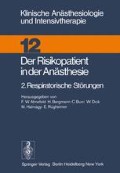Zusammenfassung
Das primäre Ziel der Respiratorbeatmung ist die Wiederherstellung und die Sicherstellung eines suffizienten Gasaustausches. Dazu muß der Respirator die Lungen mit einem adäquaten Gasvolumen in angemessener Zeit füllen, eine gleichmäßige Verteilung dieses Gases in allen Lungenabschnitten gewährleisten und die Entleerung der Lunge zu einem definierten Zeitpunkt aktiv oder passiv ermöglichen.
Access this chapter
Tax calculation will be finalised at checkout
Purchases are for personal use only
Preview
Unable to display preview. Download preview PDF.
Literatur
AMAHA, K., LIU, Ph., WEITZNER, St., HARMEL, M.: Effect of constant ehest compression on the mechanical and pathologic Performance of different Ventilators. Anesthesiology 28, 408 (1967).
BARTH, L., MEYER, M.: Moderne Narkose. 2. Aufl., Kapitel IV: Atmung, p. 326, 328. Stuttgart: G. Fischer 1965.
BARTLETT, R. H., GAZZANIGA, A. B., GERAGTHY, T. R.: Respiratory maneuvers to prevent postoperative pulmonary complications. JAMA 224, 7 (1973).
BAUM, M., BENZER, H., KUCHER, R., LEMPERT, J., MAYRHOFER, O., TÖLLE, W.: Respiratorbeatmung bei intrapulmonaler Luftverteilungsstörung. Z. prakt. Anaesth. Wiederbeleb. 4, 325 (1969).
BENZER, H., KUCHER, R., MAYRHOFER, O., BAUM, M.: Kontrollverfahren bei Respiratoratmung. Anaesthesist 18, 169 (1969).
BERGMANN, H.: Vergleichende Betrachtungen von Beatmungsgeräten. Anaesthesiologie und Wiederbelebung 27, 42 (1968).
BERGMANN, H.: Volumengesteuerte Respiratoren. In: Die Ateminsuffizienz und ihre klinische Behandlung (ed. O.H. JUST), p. 53. Stuttgart: Thieme 1967.
BERGMANN, H.: Gestörte Atemfunktion als Anaesthesierisiko. 4. Fortbildungskurs für klinische Anaesthesiologie II, p. 45. Wien 1969.
BERGMANN, N.: Effects of varying respiratory waveforms on gas exchange. Anesthesiology 28, 390 (1967).
BURCHARDI, H.: Verteilungsstörungen bei Langzeitbeatmung. In: Lungenveränderungen bei Langzeitbeatmung (eds. K. WIEMERS, K.L. SCHOLLER). Stuttgart: Thieme 1973.
COLLIS, J. M., BUSHMAN, J. A.: Ten lung Ventilators. Issue World med. Electronics 4, 5 (1969).
DICK, W., EMMRICH, P.: Beatmungsgeräte auf einer pädiatrischen Intensivpflegestation. In: Beiheft zum Arch. Kinderheilk. 63, 53 (1971).
EDWARDS, W.: Pressure-cycled Ventilators and flow-rate control. Anesth. Anaig. Curr. Res. 47, 77 (1968).
ENGSTRÖM, C. G., NORLANDER, O. P.: A new method for analysis of respiratory work by measurements of the actual power as a function of gas flow, pressure and time. Acta anaesth. scand. 6, 49 (1962).
HEITMANN, H.: Die Funktion kleiner Respiratoren zur Narkosebeatmung. Anaesthesist 19, 397 (1970).
HERDEN, N. H., LAWIN, P.: Beatmungsgeräte. In: Praxis der Intensivbehandlung, p. 268. Stuttgart: Thieme 1971.
HERZOG, H., KELLER, R.: Druckgesteuerte Respiratoren. In: Die Ateminsuffizienz und ihre klinische Behandlung (ed. O.H. JUST), p. 67. Stuttgart: Thieme 1967.
HERZOG, H.: Indikation und praktische Durchführung der Beatmung. In: Die interne Wachstation, p. 96. München-Berlin: Urban & Schwarzenberg 1969.
HILL, D. W., MOORE, V.: The action of adiabetic effects on the com pliance of an artificial thorax. Brit. J. Anaesth. 37, 19 (1965).
HOWELLS, T. H.: Automatic pulmonary Ventilators. Issue World med. Electronics, 106 (1963).
KIRBY, R. R., DOWNS, J. B., CIVETTA, J. M., MODELL, J. H., DANNEMILLER, F. J., KLEIN, E. F., HODGES, M.: High level positive endexpiratorv pressure (PEEP) in acute respiratory insufficiency. Chest 67, 156 (1975).
De KOCK, M. A., SCHOOMBIE, M. S.: The physiology of intermittent positive pressure breathing (IPPB). Sth. Afr. med. J., Suppl. 3 (1969).
LEHMANN, Ch.: Vergleiche zwischen Engström-Narkoserespirator und Dräger-Narkosespiromat. Zbl. Chir. 85, 1415 (1960).
LYAGER, S.: Influence of flow pattern on the distribution of respiratory air during intermittent positive pressure Ventilation. Acta anaesth. scand. 12, 191 (1968).
MUSHIN, W. W., RENDELL-BAKER, L., THOMPSON, P. W., MAPLESON, W. W. Automatic Ventilation of the lungs. Oxford-Edinburgh: Blackwell Scientific Publications 1969.
NACHTWEY, W.: Die künstliche Atmung bei ventilatorischen Notlagen im Gefolge interner Erkrankungen. Habilitationsschrift.
NORLANDER, O., HERZOG, P., NORDEN, I., HOSSLI, G., SCHAER, H., GATTIKER, R.: Compliance and airway resistance during anaesthesia with controlled Ventilation. Acta anaesth. scand. 12, 135 (1968).
NORLANDER, O. P.: Functional analysis of force and power of mechanical Ventilators. Acta anaesth. scand. 8, 57 (1954).
PONTOPPIDAN, H.: Effect of artificial Ventilation on circulation and blood gas exchange. In: Lungenveränderungen bei Langzeitbeatmung (eds. K. WIEMERS, K.L. SCHOLLER). Stuttgart: Thieme 1973.
RÜGHEIMER, E.: Beatmungsprobleme bei Neugeborenen und Säuglingen. Europäischer Anaesthesie-Kongreß, Prag, Sept. 1970,.
RÜGHEIMER, E.: Prophylaxe und Therapie der respiratorischen Störungen. Arch. klin. Chir. 322, 1291 (1968).
SAKLAD, M., WICKLIFF, D.: Functional characteristic of artificial Ventilators. Anesthesiology 28, 716 (1967).
STOFFREGEN, J., OPITZ, A., SONNTAG, H.: Der Takaoka-Respirator. Anaesthesist 20, 70 (1971).
TERRING, W.: Heironimus III, Mechanical Artificial Ventilation, Chapter II, p. 11. Springfield, III.: Ch. C. Thomas 1970.
Editor information
Editors and Affiliations
Rights and permissions
Copyright information
© 1976 Springer-Verlag Berlin Heidelberg
About this chapter
Cite this chapter
Rügheimer, E. (1976). Forderungen des Klinikers an ein Respiratorsystem. In: Ahnefeld, F.W., Bergmann, H., Burri, C., Dick, W., Halmàgyi, M., Rügheimer, E. (eds) Der Risikopatient in der Anästhesie. Klinische Anästhesiologie und Intensivtherapie, vol 12. Springer, Berlin, Heidelberg. https://doi.org/10.1007/978-3-642-66553-0_10
Download citation
DOI: https://doi.org/10.1007/978-3-642-66553-0_10
Publisher Name: Springer, Berlin, Heidelberg
Print ISBN: 978-3-540-08039-8
Online ISBN: 978-3-642-66553-0
eBook Packages: Springer Book Archive

